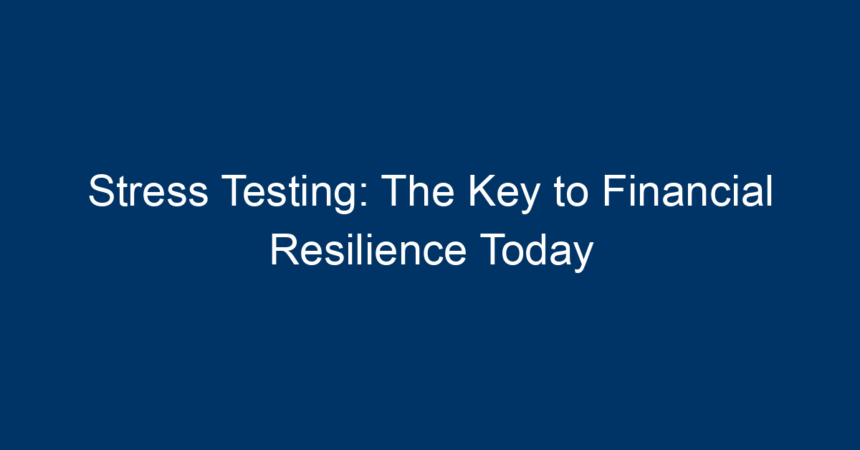In today’s volatile economic climate, the imperative for businesses and financial institutions to maintain their financial resilience cannot be overstated. Amidst uncertainty, stress testing has emerged as a critical tool for organizations looking to safeguard their operations and strategies. This article delves into the significance of stress testing, its methodologies, benefits, and actionable insights for improving financial resilience.
What is Stress Testing?
Stress testing is a simulation technique used to evaluate how various stress scenarios could impact an organization’s financial health. The primary purpose is to determine how extreme economic conditions—like a severe recession, sudden market fluctuations, or even specific operational risks—could affect an entity’s capital, liquidity, and overall stability.
Organizations employ stress testing to:
- Identify Vulnerabilities: Understand weak points in their financial structure.
- Enhance Risk Management: Inform better decision-making in risk-managing strategies.
- Ensure Regulatory Compliance: Meet legal obligations set forth by financial regulators.
In a nutshell, stress testing serves as a realistic rehearsing ground for organizations to prepare for the unexpected.
Why Stress Testing is Essential Now More Than Ever
1. Navigating Economic Uncertainty
The global economy has witnessed unprecedented volatility in recent years. Factors such as geopolitical tensions, the COVID-19 pandemic, and fluctuating interest rates have created a precarious environment for businesses. Stress testing provides companies with the insights they need to not only survive but thrive during uncertainty.
2. Regulatory Requirements
Regulatory bodies worldwide have increasingly mandated stress testing as a part of their framework. Compliance with these regulations is essential for financial institutions that seek to operate sustainably and maintain customer trust. For instance, the Dodd-Frank Act in the United States and similar regulations in Europe require banks to conduct regular stress tests.
3. Enhancing Investor Confidence
Investors are more likely to place their trust in companies that exhibit mindful risk management practices, including conducting rigorous stress tests. Transparency about stress testing results can also improve investor relations by showcasing a firm’s preparedness for various scenarios.
Types of Stress Testing
Understanding the different approaches to stress testing can help organizations select the most effective methods for their needs.
1. Sensitivity Analysis
This approach focuses on identifying how sensitive a specific variable (such as interest rates or market prices) is to changes in financial performance. By adjusting individual factors and observing the outcomes, companies can determine which variables have the most significant impact on their financial health.
2. Scenario Analysis
Scenario analysis examines extreme but plausible conditions, such as a recession. Organizations create hypothetical adverse scenarios and analyze their potential effects on capital adequacy, liquidity, and overall viability.
3. Reverse Stress Testing
This is a less common but equally important method that starts with a particular adverse outcome—like running out of cash—and works backward to identify what scenarios could lead to such a result. This method can uncover unexpected vulnerabilities and weaknesses in an organization’s strategies.
Implementing an Effective Stress Testing Framework
Implementing an effective stress testing framework requires careful planning and execution. Here are key steps organizations should consider:
1. Define Objectives Clearly
Before initiating stress tests, organizations must outline explicit objectives. Clarifying whether the goal is to meet regulatory requirements, enhance strategic planning, or assess liquidity can streamline the process.
2. Collect and Analyze Data
Robust data is crucial for effective stress testing. Organizations must gather historical data and relevant financial metrics to create a sound base for simulation. This may include revenue streams, expenses, debt levels, and liquidity ratios.
3. Develop Scenarios
Creating realistic yet severe scenarios that reflect potential economic downturns or operational disruptions is vital. Engaging with different stakeholders can enrich the scenario development process and ensure that it captures various perspectives.
4. Test and Review
After running stress tests, it’s essential to review the findings comprehensively. Analyze the results closely to pinpoint weaknesses and discuss them with key decision-makers. This step is crucial for making informed changes.
5. Reflect and Act
Once the stress testing results are in, organizations must act on the insights gathered. Adjusting financial strategies based on stress test outcomes can lead to a more resilient organizational framework.
Benefits of Stress Testing
1. Proactive Risk Management
Organizations can spot potential risks before they materialize, allowing them to take proactive steps to mitigate adverse effects.
2. Financial Stability
Conducting stress tests can help organizations ensure sustainable financial health, providing much-needed stability in turbulent times.
3. Enhanced Strategic Planning
Stress testing enables better strategic planning by informing management about potential risks and opportunities. Organizations can align this knowledge with their long-term goals, ensuring they remain agile and prepared.
4. Better Capital Requirements
Knowledge gained from stress testing can guide businesses in determining their capital needs more accurately. This ensures that firms are well-positioned to meet both regulatory requirements and operational demands.
Common Challenges in Stress Testing
1. Data Quality and Availability
One significant challenge in stress testing is ensuring that the data is accurate, comprehensive, and easily accessible. Poor data quality can skew results, rendering the stress test ineffective.
2. Regulatory Complexities
The regulatory landscape is continually evolving, making it challenging for organizations to stay compliant. Regularly updating stress testing methodologies to align with new regulations is essential but can be a daunting task.
3. Resource Intensive
Conducting thorough stress tests requires both time and expertise. The need for skilled personnel, technological capabilities, and financial resources can pose obstacles for smaller organizations.
Conclusion: Embrace Stress Testing for Financial Resilience
Stress testing is imperative for organizations seeking to navigate the complexities of today’s financial landscape. By implementing effective stress testing frameworks, businesses can improve their risk management strategies, comply with regulatory requirements, and ensure long-term financial stability.
Actionable Insights:
-
Start Small: If your organization hasn’t implemented stress testing yet, begin with basic sensitivity analysis and gradually expand to more complex scenario analyses.
-
Collaborate Across Departments: Encourage collaboration among different departments to gain diverse insights into potential risks and scenarios.
-
Regular Reviews: Make stress testing a regular practice instead of a one-off exercise. This will help in adapting to changing market conditions more efficiently.
- Invest in Technology: Use technology to streamline data collection and analysis processes, ensuring that your stress tests are effective and efficient.
By embracing stress testing today, organizations can become more resilient against the uncertainties of tomorrow, effectively safeguarding their future.



